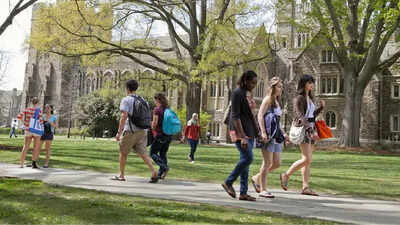America’s shrinking welcome mat: Report warns Silicon Valley risks big by turning away foreign students

The United States, a nation that is synonymous with a haven of opportunities, is scrambling to uphold its long-cherished prestige. For over a century, America has stood as a magnet, pulling ambitious minds and utopian hearts from across the globe. Its universities are not just learning institutions but are conducive grounds for world-changing ideas, businesses, and leaders. But today, as the nation tightens the noose around its immigration policies and sends mixed signals to foreign students, a crucial question emerges: What does America stand to lose by narrowing its doors to international students?A new report by the Institute of International Education (IIE) lays bare the stakes. Amid a looming domestic enrolment cliff, intensifying global competition, and a swelling tide of international academic mobility, the United States is at risk of forfeiting one of its greatest long-term strategic advantages. The costs economic, intellectual, and geopolitical, may not be immediate, but they are mounting. And if Washington does not recalibrate soon, it could be trading tomorrow’s prosperity for today’s politics.
A multi-billion dollar economic engine at risk
The impact in itself transcends beyond tuition payments. These students support local housing markets, stimulate consumer spending, fund research programmes, and assist in sustaining faculty positions at numerous institutions, especially smaller colleges outside major metros. At a time when US universities are scrambling with declining domestic enrolments, over two million fewer undergraduates between 2010 and 2022, per federal data, losing foreign students is not just an inconvenience; it’s a fiscal crisis in the making.To pull the rug out from under this economic pillar would be shortsighted at best, and self-destructive at worst.
A brain drain in reverse
International students are not just consumers, but rather catalysts. Data speaks for themselves, more than 50% of them enrol in STEM fields according to media reports, contributing directly to America’s innovation economy. Many go on to become engineers, scientists, healthcare professionals, and tech entrepreneurs, filling gaps in critical sectors already stretched thin.The US Chamber of Commerce has forecast talent shortages in fields like healthcare, computer science, and finance in the coming decade. These are the very areas where international students are best trained to step in. Turning them away means widening the skills gap, slowing innovation, and weakening the workforce pipeline.While countries like Canada and Australia are rolling out the red carpet for global talent, with seamless pathways from education to residency, the US is at risk of creating a brain drain in reverse, sending talent nurtured on American soil to competing nations.
An eroding foundation of soft power
The influence of United States has never been primarily dependent on military might or trade. For decades, much of America’s global clout has flowed from its universities. Foreign students educated in the US often return home with deep ties to American institutions, values, and ideals. They become diplomats in their own right, leading governments, building businesses, and fostering long-term partnerships that benefit both nations.By shrinking its international student intake, the US risks passing the golden baton to others. Countries like China, Germany, and UK have identified that student mobility is not just an educational ordeal- it is a foreign policy tool. In contrast, America’s increasingly adversarial approach, highlighted by visa delays, policy flip-flops, and post-study work restrictions, is alienating the very individuals who might have battled the American cause abroad.In essence, the nation is burning bridges that took decades to build.
The innovation pipeline may run dry
Silicon Valley owes much of its success to immigrant founders, many of whom arrived as international students. Giants like Google, Tesla, and Intel were co-founded or significantly shaped by foreign-born talent educated in the US.The IIE’s report highlights that Optional Practical Training (OPT), which allows international graduates to work temporarily in the US, has seen rising participation, even as new student enrolments fluctuate. The trend speaks clearly without mincing words that students still look up to American education; however, they are apprehensive about the uncertainty that the nation poses.If the US continues to make post-graduation pathways unpredictable, the message is stated in black and white: “Come to study, but don’t expect to stay.” When bright minds and talented individuals are shoved under the carpet, they navigate their path to somewhere else, to countries that bestow not just education but opportunities.
A missed demographic lifeline
The United States is not just facing an enrollment dip, it is staring down a demographic cliff. According to the IIE, the number of high school graduates in the US will peak in 2025 and decline by 13% by 2041. This means fewer students entering college, fewer degrees earned, and fewer skilled workers entering the economy.International students could help blunt this decline. With global mobility surging, 6.9 million students studied abroad in 2024, projected to reach 9 million by 2030, the US has access to a robust and expanding talent pool. Countries like India and Nigeria, both facing massive higher education capacity constraints at home, present especially rich pipelines.Ignoring this resource isn’t just a lost opportunity; it’s a self-inflicted wound.
The peril of playing short
The debate over international students in the US is often cut off to immigration headlines or political soundbites. But this is not limited to the question that who gets a visa, it is about who powers the American economy, who staffs hospitals and tech firms, who sustains its universities, and who carries its ideals forward.To turn away international students now is to cut off the nose to spite the face, a reactionary move with long-term repercussions. As other nations embrace the future with open arms, the US cannot afford to be caught napping at the gate.In the end, what America stands to lose is not just tuition revenue or temporary talent. It risks forfeiting its place as the global epicentre of higher education and innovation. And once that ground is ceded, reclaiming it may prove far harder than anyone anticipates.





